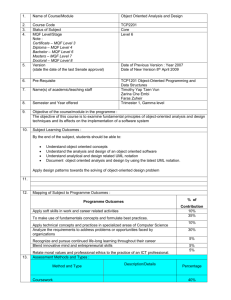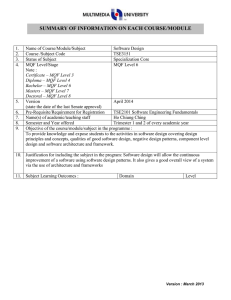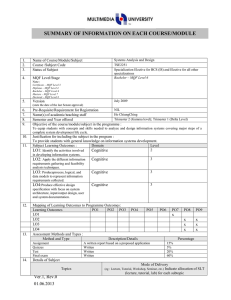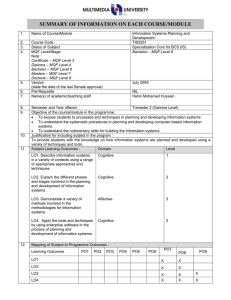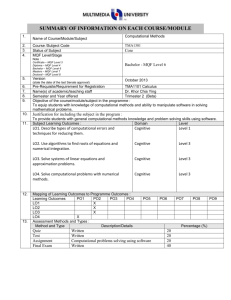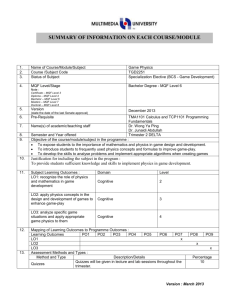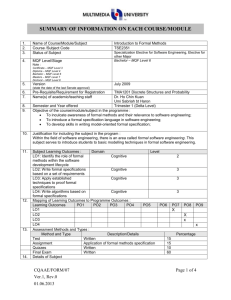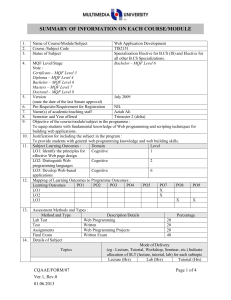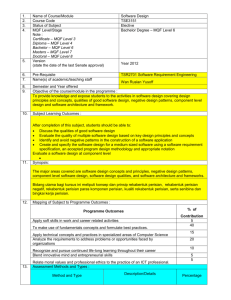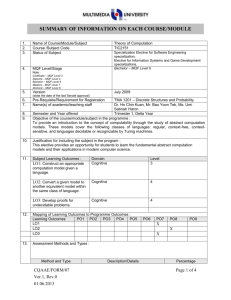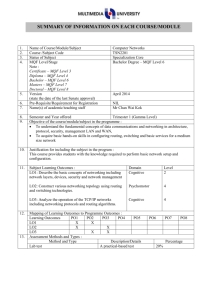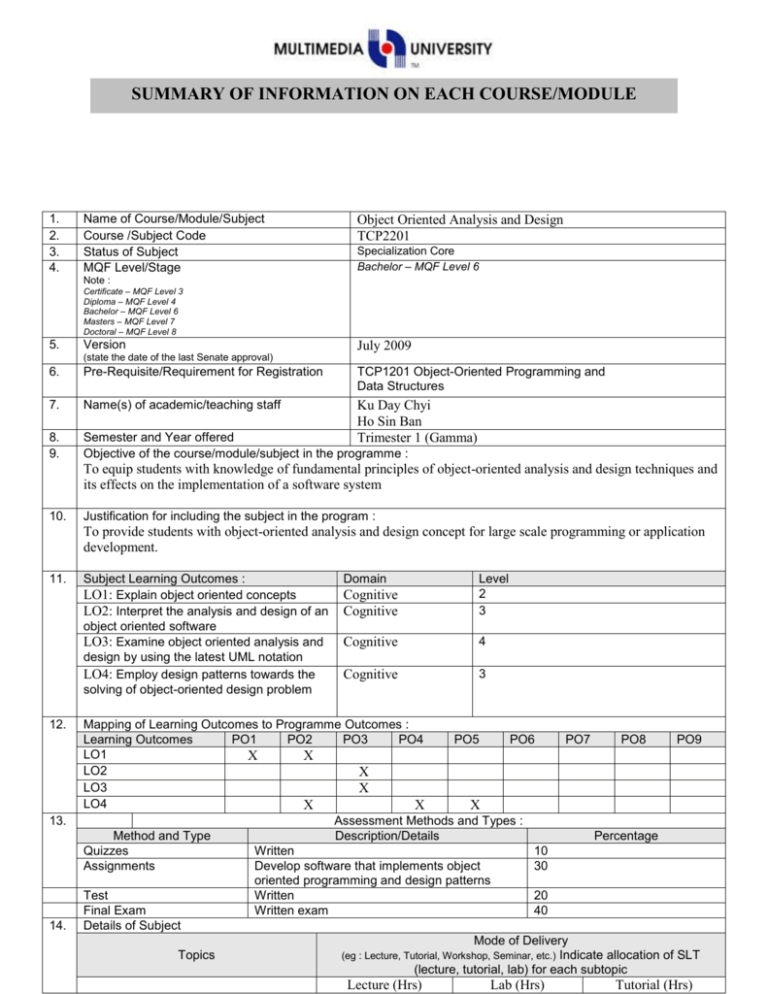
SUMMARY OF INFORMATION ON EACH COURSE/MODULE
1.
2.
3.
4.
Name of Course/Module/Subject
Course /Subject Code
Status of Subject
MQF Level/Stage
Object Oriented Analysis and Design
TCP2201
Specialization Core
Bachelor – MQF Level 6
Note :
Certificate – MQF Level 3
Diploma – MQF Level 4
Bachelor – MQF Level 6
Masters – MQF Level 7
Doctoral – MQF Level 8
5.
Version
July 2009
(state the date of the last Senate approval)
6.
Pre-Requisite/Requirement for Registration
TCP1201 Object-Oriented Programming and
Data Structures
7.
Name(s) of academic/teaching staff
8.
9.
Ku Day Chyi
Ho Sin Ban
Trimester 1 (Gamma)
Semester and Year offered
Objective of the course/module/subject in the programme :
To equip students with knowledge of fundamental principles of object-oriented analysis and design techniques and
its effects on the implementation of a software system
10.
Justification for including the subject in the program :
To provide students with object-oriented analysis and design concept for large scale programming or application
development.
11.
12.
13.
14.
Subject Learning Outcomes :
LO1: Explain object oriented concepts
LO2: Interpret the analysis and design of an
object oriented software
LO3: Examine object oriented analysis and
design by using the latest UML notation
LO4: Employ design patterns towards the
solving of object-oriented design problem
Domain
Cognitive
Cognitive
Level
2
3
Cognitive
4
Cognitive
3
Mapping of Learning Outcomes to Programme Outcomes :
Learning Outcomes
PO1
PO2
PO3
PO4
PO5
PO6
PO7
PO8
PO9
LO1
X
X
LO2
X
LO3
X
LO4
X
X
X
Assessment Methods and Types :
Method and Type
Description/Details
Percentage
Quizzes
Written
10
Assignments
Develop software that implements object
30
oriented programming and design patterns
Test
Written
20
Final Exam
Written exam
40
Details of Subject
Mode of Delivery
Topics
(eg : Lecture, Tutorial, Workshop, Seminar, etc.) Indicate allocation of SLT
(lecture, tutorial, lab) for each subtopic
Lecture (Hrs)
Lab (Hrs)
Tutorial (Hrs)
1. Object Oriented Fundamentals
What is Object Oriented, Models,
Classes, Objects, Encapsulation,
Abstraction, Inheritance, Polymorphism,
Generalization.
2
2
2. Object Oriented Analysis
Overview of analysis, Analysis Object
Model and Dynamic Model, Entity,
Boundary and Control Objects,
Generalization and Specialization
6
4
3.Object Oriented System Design
Overview of design, Subsystem and
classes, Services and subsystem
interfaces, Coupling and cohesion,
Layers and partition
6
8
4. UML and Object Oriented Analysis
and Design
Overview of UML, Use Case Diagrams
Class Diagams, Interaction Diagrams
Statechart Diagrams, Activity Diagrams
8
8
5. Introduction to Design Patterns
Reuse concepts, Selecting Design
Patterns, Heuristics for selecting design
pattern, examples of design patterns
(execution pattern, implementation
pattern, structural design pattern etc)
4
4
26
15.
16.
17.
Total Student
Learning Time (SLT)
Lecture
Quizzes
Laboratory
Presentation
Assignments
Test
Final Exam
Sub Total
Total SLT
26
Independent Learning
Face to Face
26
26
2
26
3
18
10
20
111
26
1
2
55
Credit Value
Reading Materials :
Textbook
160
4
Reference Materials
Grady B, Robert A. M, Michael W. E, Bobbi J. Y, Jim
C, Kelli A. H, Object-Oriented Analysis and Design
with Applications(Third Edition),Addison Wesley
Professional, 2007
18.
Brett D. M, Gary P & David W, Head First ObjectOriented Analysis & Design, O’Reilly, 2006.
Eric F, Elisabeth F, Bert B and Kathy S, Head First
Design Pattern, O’Reilly, 2004.
Bernd B, Allen H. D, Object Oriented Software
Engineering Using UML, Patterns and Java,
Pearson Prentice Hall, 2nd Edition, 2004.
Appendix (to be compiled when submitting the complete syllabus for the programme) :
1. Mission and Vision of the University and Faculty
2. Programme Objectives or Programme Educational Objectives
3. Programme Outcomes (POs)
4. Mapping of POs to the 8 MQF domain
5. Mapping of Los to the POs
6. Summary of the Bloom’s Taxonomy’s Domain Coverage in all the Los in the format
below :
Subject
Learning
Outcomes
(please state
the learning
0utcomes)
Bloom’s Taxonomy Domain
Affective
Cognitive
Psychomotor
7. Summary of LO to PO measurement
8. Measurement and Tabulation of result for LO achievement
9. Measurement Tabulation of result for PO achievement
Mapping Learning Outcome to Assessment
No.
A1
Assessment
LO1
LO2
LO3
LO4
Assignments
(30%)
X
X
X
X
A2
Quizzes (10%)
X
X
A3
Test (20%)
X
A4
Final Exam
(40%)
X
X
X
X

